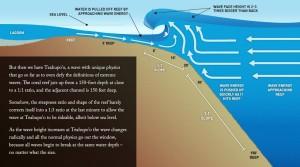Waves are generated by wind. Offshore storms generate winds which blow on the surface of the sea and create ripples, much in the same way as the ripples in your post surf cuppa are made when you blow on it to cool it down. The wind can be seen on weather maps as low pressure areas. The more tightly packed the isobars are on the weather map the stronger the winds will be. Small waves (capillary waves) are initially generated in the direction that the wind is blowing. The stronger and longer the wind blows, the more effect it has on these ripples and the larger they become. Initially the waves will just be small chop, but these will soon increase in size. As the wind continues to blow and the waves generated remain under the influence of the wind, the smaller waves will increase in size. The wind will get hold of the small waves much more easily than the calm sea surface. The wave size is dependent on the wind speed generating it. A certain wind speed will only be able to generate a wave of certain size. Once the largest waves that can be generated for a given wind speed have formed, the seas are “fully formed.” Waves being generated have differing speeds and wave periods. The longer period waves are faster and move farther ahead of the rest of the slower waves. As the waves travel farther away (propagate) from the wind source, they start to organize themselves into swell lines. “Wave trains” form and these inevitably hit the beach at the same time. You may have heard of sets already!











